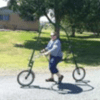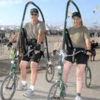GLIDECYCLE MOBILITY DEVICE REDUCES GROUND REACTION FORCES COMPARED TO RUNNING IN HEALTHY INDIVIDUALS
Jordan Perry
A. Wayne Johnson PhD, PT
Sarah T. Ridge PhD
Gary W. Mack PhD, FACSM
Dennis Jordan
Alex Johnson
Brigham Young University, Department of Exercise Sciences
College of Life Sciences,
106 SFH, Provo, UT 84602
PURPOSE
This study quantified the ground reaction forces (GRF) of participants riding the GlideCycleTM (alternative method of exercise for individuals with amputation or decreased weight-bearing status which allows for cardiovascular exercise in the outdoors). No previous studies have quantified the GRFs of this method of exercise.
METHODS
The dominant leg of twenty participants (age 22 ± 2.8 years, weight 68.2 ± 10.8 kg, height 1.77 ± 0.1 m) was determined; this leg struck the force plate (Kistler North America) embedded in an indoor track in all trials during the study. Participants were given instructions on how to use the GlideCycleTM. The GlideCycleTM was adjusted individually by moving the seat height so that a 40° knee angle was obtained with the foot flat on the ground. Familiarization of the GlideCycleTM included ~650 meters running practice. Participants then ran unsupported and then supported in the GlideCycleTM for 6 trials each. Participants started approximately 50 m from the force plate and traveled at a speed estimated to be ~4 m/s. Force data was normalized to the participant’s body weight (BW) and was analyzed using custom LabView software.
RESULTS
GlideCycleTM reduced ground reaction force significantly compared to running (t= 22.3 p< .001). On average, running produced a peak GRF of 2.39 ± .14 BW, while the GlideCycleTM .34 ± .004 BW, a difference of 2.05 BW.
DISCUSSION/CONCLUSION
GlideCycleTM GRFs were far smaller than traditional running. This device is suggested to allow amputees and other individuals with decreased weight-bearing status due to pathology, such as osteoarthritis, to engage in outdoor exercise. Based on the results of this study it does allow outdoor exercise with reduced impact to joints compared to running…some users may need training to accommodate to the device (as to a bicycle).






